#you remove an opponent's small-to-moderate creature and then you get a big creature (with a small downside)
Note
You're cool
The new ranked season on MTG Arena just started and I did a quick draft this morning, and I got matched against the bottom-of-the-barrel bronze players I've seen in months. They attacked me with a 4/4 when I had a 5/5 vehicle primed and ready to be crewed, and I figured "oh dang, I guess they have a combat trick. oh well, I'll force them to use it" so I blocked. And they just let their 4/4 die. So THEN I was like "oh I guess they just attacked to trigger its ability? not really worth it tho." And THEN they played a Dusk Rose Reliquary on my vehicle (exiles a creature or artifact). After combat. That they had in their hand from the start. Did they just... forget that vehicles can block? Truly, we cannot comprehend the advanced tactics of the bronze rank players.
#asks#unfortunately i went 3-3 on that draft#in 2 of the games all my stuff got removed and i kept drawing noncreatures#and in the 3rd loss i drew all mountains with a hand full of white cards#vehicle was Bladewheel Chariot btw#seriously that card is so good i can't believe they printed that#so many craft cards are like “pay 3 mana for a shock and then 3 more mana for a decent equipment”#just terrible overpriced sorcery effects with transformed sides that are NOT strong enough to justify it#then Spring-Loaded Sawblades comes in and is literally just 2 decent cards stapled together#5 damage to a tapped creature for 2 mana? that's just a better Summary Judgement!#and then 4 mana for a 5/5 crew 1 vehicle with an alternate crew condition? solid! not great but solid!#this card is 2 cards#you remove an opponent's small-to-moderate creature and then you get a big creature (with a small downside)#craft cards are basically just adventures the more i think about it#except going on the adventure is mandatory
1 note
·
View note
Text
Two guilds, one cause group commentary
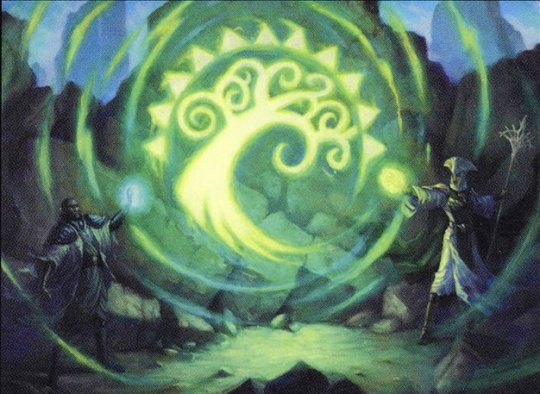
Super sorry for being super super late. Here’s the commentary about the guild colab cards.

@dumbellsndragons First of quite a lot split/aftermath cards for this contest! I was quite surprised! Beast is not much but it’s an honest spell. The real deal is Breakfast! It essentially doubles the power of your board, by splitting it to 2/2 bodies that can in turn trigger various etb effects. Temporary buffs, (bloodrush anyone?) can play a huge roll on how many tokens you can make!

@i-am-the-one-who-wololoes Misjudged this one, took it for an Izzet Simic spell, while it’s actually an Izzet Gruul one that plays into the destroy to create mentality of the two guilds. While witty and creative, this spell feels a little too specific. It definitely has a fun side but I fear people would use it more as a combo piece.
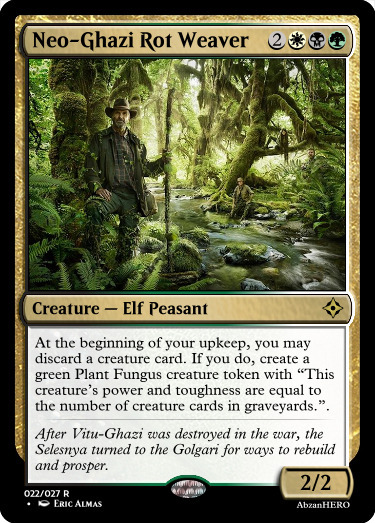
@abzanhero Sel-gari was a very popular combination and Rotweaver is a very nice example on how those two guilds could interact. It fills the graveyard, cares about the graveyard and has the potential to make HUGE tokens for you to populate. All that in the expense of immediate impact on the board, but I asked for kitchen table EDH cards, and this fits the category very well.
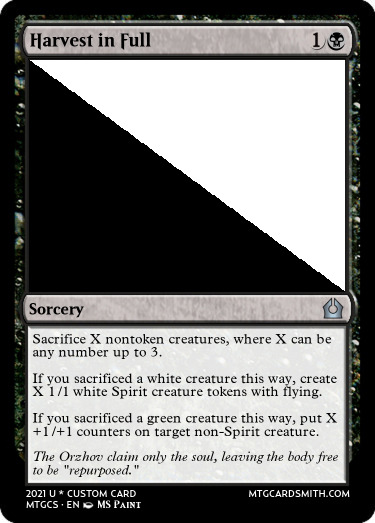
@helloijustreadyourpost I love the throwback to popular EDH cards like Savra and the first print of Teysa that care about the color of creatures you control. That said, I am not a fun of the limitations on the card, as I view more like a Yu-gi-oh design than an mtg card, where usually the only limitation is the cost of the card.
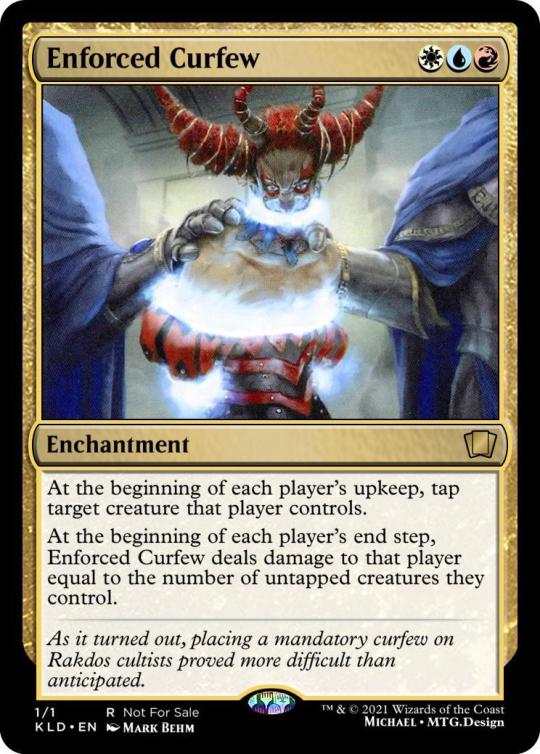
@bioodprice Great control card but the two triggers feel conflicted as the one taps a creature, and the other punishes the players for having untapped creatures. Either way, it has good pillowfort potential as it can hinder both voltron strategies and punish token based decks.
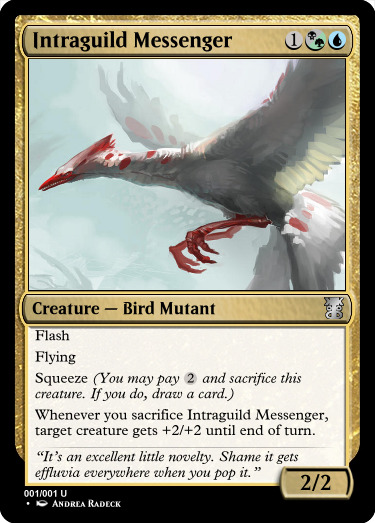
@dimestoretajic Great tempo card, would do wonders in limited enviroments. Lorewise, it’s sad to see that guilds consume their messengers. If this trend continues, Vivien will surely pay Ravnica a visit XD
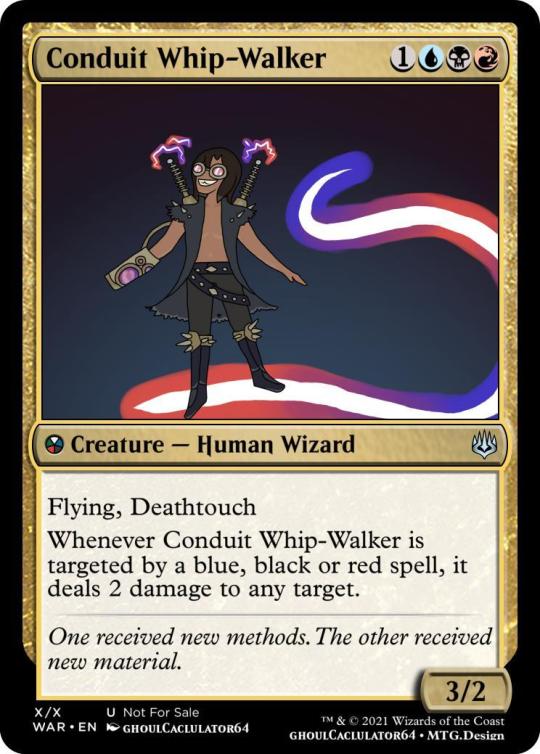
@ghoulcaclulator64 First of all, congratulations for going the extra mile and made your own artwork for the card! It’s really cool!
On to the ability of the card, its very well stated and it has great combo potential with all the copy effects of blue and red that can help you create an army of deadly blasters. I am not sure whether you wanted the trigger to work with spells any player controls or not, but all in all I find Whip-Walker an interesting design!
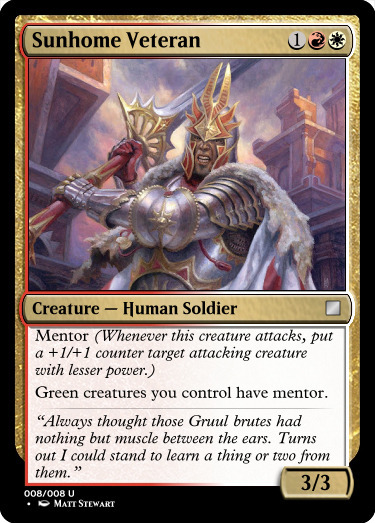
@kytheon4-4 Great flavor text that fits the theme of the design challenge 150%! Also a quite impactful card on a tri colored creature deck of all shapes and sizes. If mentor returns, it could definitely appear on Green creatures, or creatures of any color, like Exalted
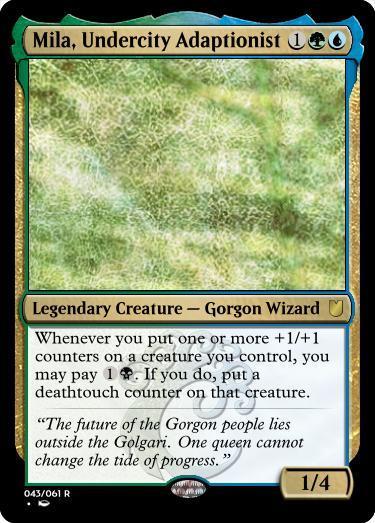
@hypexion When you’re a Gorgon with a Biology major, there’s no need to stay in the undercity XD In general I like the use of ability counters, and this applies here as well. The +1/+1 counter would serve as a reminder for the deathtouch counter, though I must complain that Mila herself doesn’t have deathtouch but has to work for it like a guildless peasant.
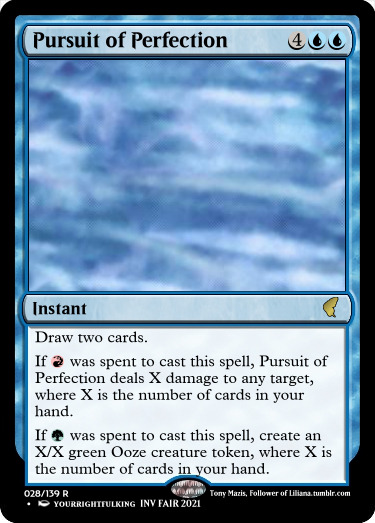
@yourrightfulking For GGUURR you get two cards and at least a 2/2 body plus 2 damage wherever you want. This is an insanely good deal, and this being an instant means that you can also mess up combat big time. I wouldn’t call the card broken in any way but I feel there should be some moderation, maybe the damage affect players and planeswalkers? But that’s me nitpicking, all in all pursuit of perfection was a very nice entry for the contest.

@nine-effing-hells In a similar vein, from a mechanical standpoint, chorus of battle offers +4/+4 , with the additional trample and lifelink. Comparison with Titanic Ultimatum is inevitable, and it offers a lot more for an additional mana. I think here it should be safer if the play was asked to offer a single R and W to get the bonus and not the double colors which add a lot of weight to the card without clear benefit.
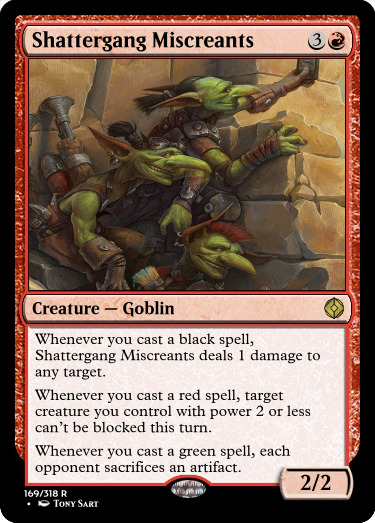
@misterstingyjack The design challenge was meant for you to design tri colored cards. There were a few color matters submissions, but this is the best “rulebreaker” and who’s a better rulebreaker than a goblin gang that pays homage to Shattergang Brothers A really cute card whose effects are relevant in an EDH game, especially the green one. Death to the mana rocks!
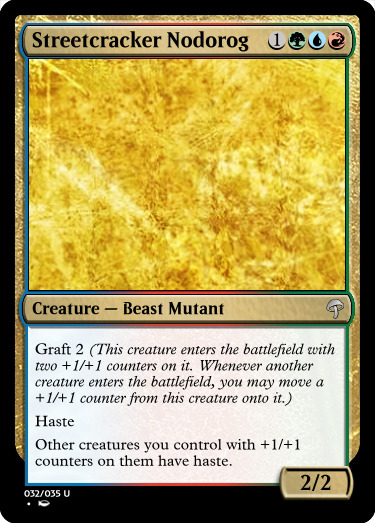
@grornt Great revisiting of Graft and I love the fact that with haste, the total damage you can do to the opponent doesn’t change as you pass around your counters! Interestingly, Riot and Bloodthirst also operate with +1/+1 counters so this beasty truly unites Simic and Gruul!

@hiygamer If there’s one thing “cannon” in this challenge, it’s that the Selesnya and the Golgari will rebuild Vitu-Ghazi! The abilities and the overall flavor of the card are super sweet, but I think we should be wary of lands with the potential to generate tons of mana. For example, as much as I love symmetry in design, the graveyard matters part of the card shouldn’t be on equal ground with the other ability as it’s easier to produce more mana with mill shenanigans.

@col-seaker-of-the-memiest-legion This pricey enchantment is so splashy, Kiora would probably try to steal it. Good thing you considered planewalkers on the second ability, because then you would have certainly crossed the line. I don’t know what kind of deck is the true home for this card, but even one turn with this card on the battlefield will decide the course of the game.
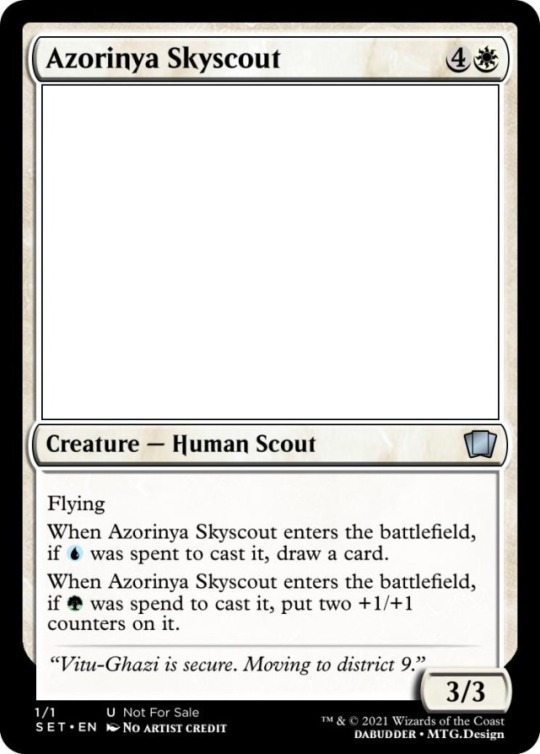
@dabudder For 2WUG, you get a 5/5 flyer and you draw one card. It’s not much, in EDH at least, but it’s definitely an honest play. Again, the fate of Vitu-Ghazi is on the spotlight, and here we see the Azorius care about it! Who knew Ravnicans love Selesnya that much?
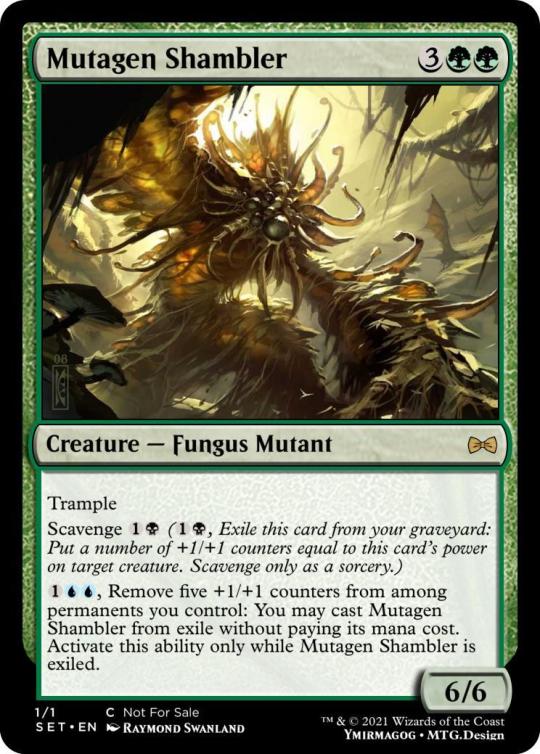
@koth-of-the-hammerpants Scavenge 6 for merely two mana is a tremendous deal. The Second activated ability takes an A for creativity and flavor, as we see the pinnacle of recycling in this combined Simic Golgari project. I feel a few balance tweaks are required here and there but the idea of a creature “reforming” itself through +1/+1 counters is damn cool.

@narkis24 Puns and memes are always appreciated but the abilities, while interesting, they have me wondering whether this is too oppressive for your opponent. The free treasure token every now and then is pretty innocent and it may be the token of an unofficial alliance made on the kitchen table. However, the potential of multiple counterspells with little investment seems a bit scary. I would rather it somehow required self sacrifice in the ability so people don’t gang up on you.

@thedirtside I love the name and its connection with the bouncing nature of the card. While overall this spell feels weak or requires a lot of mana, I feel there are decks out there that would appreciate the utility this card offers.

@bread-into-toast Selesnya and Orzhov is a wild combination from every perspective but as the flavor text suggests, all woodshapers are welcome XD
The 5 toughness guarantees that you will make a good number of tokens before this thrull enters the soil, and it might deter a couple attacks while on the battlefield because it can potentially make 10 or more tokens with a good block. An Abzan token deck will have dozens of ways to utilize this small army, and the deat trigger gives you yet another one if there are not any available at that time. All in all, a stellar design. I didn’t do a runners up post this time, but this could be easily included.

@gollumni A solid utility 4 drop that shines more at late game than on curve because as the challenge suggests we’re playing kitchen table edh. For the full colored cost you disable three potential blockers. I love the tiny detail that unlike other creatures in the original ravnica that cared about different colors of mana when you cast them, Enlisted Banisher represents all three colors for the sake of devotion and color matters cards, like the beloved Knight of New Alara.
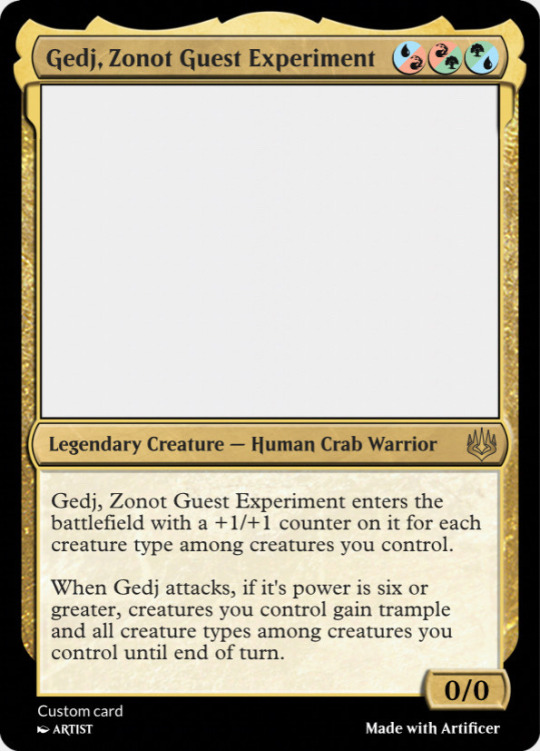
@shakeszx A very unique design that encourages different tribal strategies in an attempt to unite everything under its glorious pincers during combat. I feel a deck with Gedj as a commander would be both fun and challenging to build. I suppose it would contain a lot of Slivers and Allies. If anybody makes this deck please let us know!
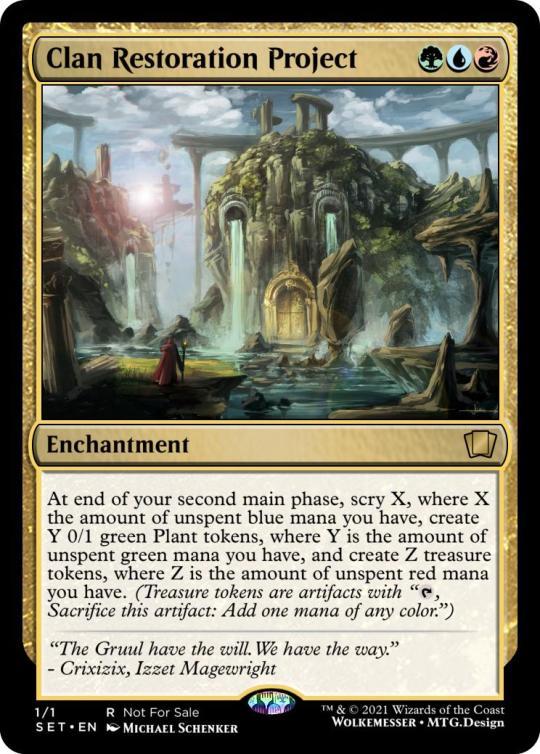
@wolkemesser A wild project uniting Gruul and Izzet. This is probably the most intricate design I’ve seen in a while, utilizing XYZ, three colors, two kinds of tokens. But what about the kitchen table? The options this card offers are insanely good, so much that I think it’s undercosted. The red ability, essentially lets you save up mana, and treasures can also help you generate mana for the other two options of the card.
And while the power level is definitely high, I have to commend you for considering when the player is allowed to do these crazy mana sink shenanigans. Having a specific time window is important and setting it on main phase 2 means that you give both yourself and you opponents time to figure things out.
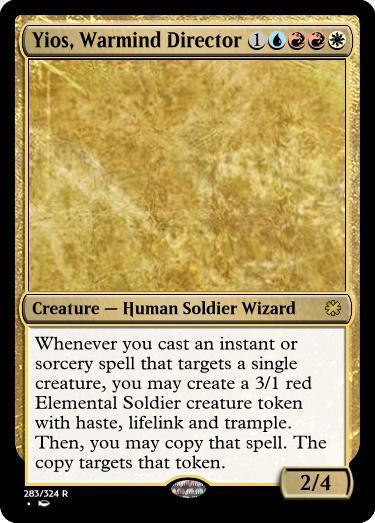
@teaxch Excellent build around potential and I like that the optional copying trigger as you can utilize a deck with both buffs and single target removals. The spiciest thing about this card is that it has the highest cannon potential because actually Izzet and Boros collaborate to create advanced soldiers. It’s Captain Amrica all over again :P They even got the right colors
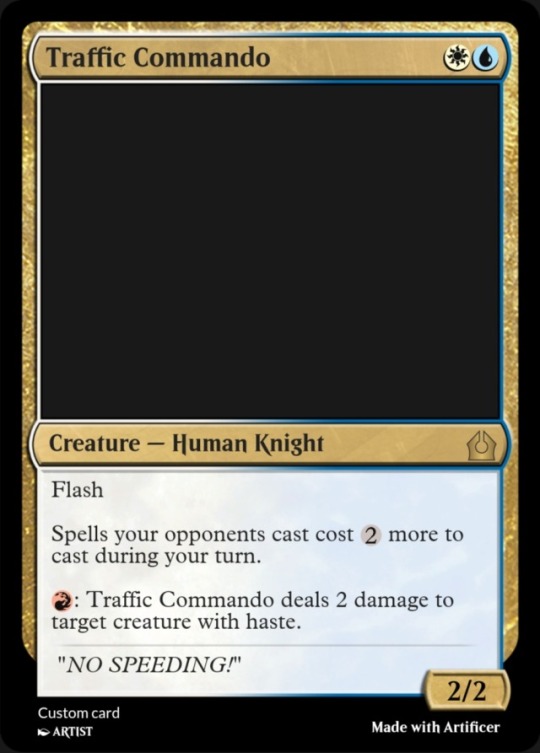
@masternexeon I love the irony of a card that obstructs your opponents playing cards during your turn has flash itself. It’s a real solid hate bear. The haste hating is more of a trinket text than a relevant ability, but it’s better to have a rare ability than not having it.
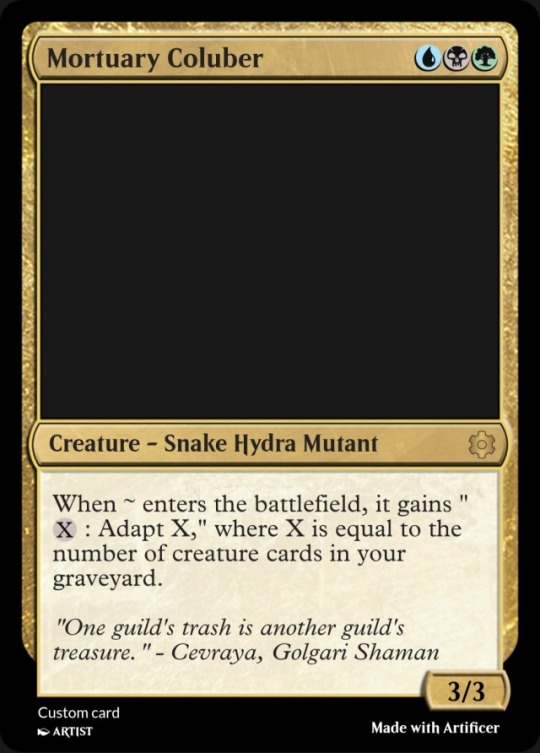
@partlycloudy-partlyfuckoff I don’t know why this doesn’t have a straightforward adapt X ability, let’s move past that. Any numbers of counters are always welcome, but in this design it’s easier to get a good amount of counters early game, for example going for 4 on turn 4 is a really nice play and you can swing for 7, which will have a long and memorable impact on the kitchen table. On the other hand, if you topdeck this late game, there’s a chance you won’t be able to pay 11 for the 11 creatures you might have in the graveyard.
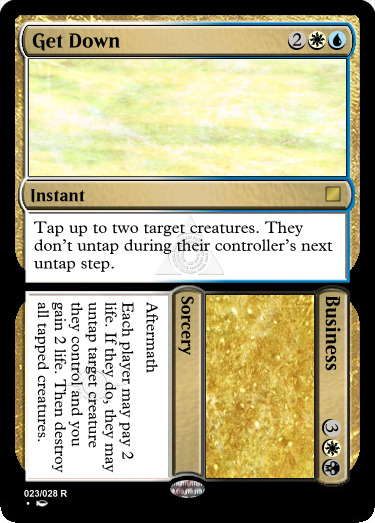
@davriel-canes-tea-supplier Another aftermath card. You surprised me there!
Get down is a slightly more expensive freeze two spell, but that’s customary for dual purpose cards like this. On to business, we got a selective wrath effect. It’s more disruptive than an actual sweeper because odds are the opponent sees it coming (except if you discard it on purpose to head straight to business) Overall I feel the whole card could be a bit cheaper but I appreciate the impact it can have in the game, and it also helps me create an image of the Ravnican lobby that’s in the hands of Orzhov with the assistance of the Azorius
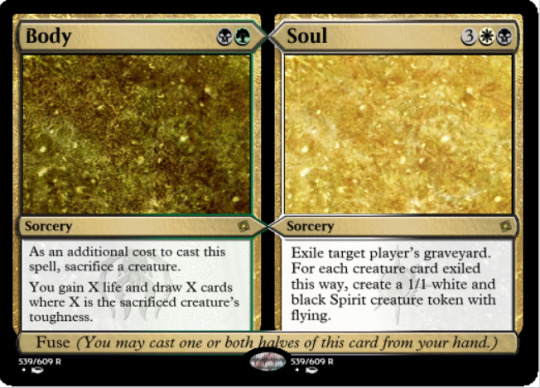
@reaperfromtheabyss Ending, with a flashy comeback of Fuse! Both halves are great cards in their own right, Body is a tad better than life’s legacy because it also gives life at the price of one black mana instead of any mana, and Soul can produce a respectable amount of flying tokens while wiping a player’s graveyard. The combined effect isn’t as explosive as other fuse spells, but the utility it offers is much appreciated. And while the card frame for fuse isn’t flavor text friendly, I really like the story it tells, about how the two guilds care about death and how they utilize it for their advantage.
12 notes
·
View notes
Text
Character skill sets
Obviously, you don’t really want a character that brings nothing to the table. On the other hand, a character who can do anything and everything so good that they can compete with deities dedicated to the subject of the day is often too much for the average reader to believe. There’s also a matter of how well the skills mesh together in practice, the amount of variety brought to the table, the difference between a developed skill and a mere talent, the nature of the skills - are they the sort of thing that anyone can develop or are they based on some inherent trait? - and how age and life experience plays into building a character’s ‘resume’.
It’s, as you can tell by the small laundry list I just rattled off, a tricky business.
Good news - there aren’t any hard and fast rules to giving characters skills. There are some guidelines and you’ll often find yourself playing by ear to see if your latest take strikes a sour note or not, but there are only a few ways to really do it wrong and, even then, there’s ways to salvage it.
But let’s focus on the points I listed already.
Let’s Play ‘Pick The Protagonist’ - (The Problem Of The Unique Protagonist Asset)
How many stories have you watched or read where the main character has a special, one-of-a-kind ability that makes them stand out above all the other characters in the story?
The answer is probably ‘a lot’. It can take the form of a one-in-a-million power, a sacred sword that only allows one hand to wield it, a legacy passed down over the ages... there’s a lot to work with here.
There’s nothing wrong with doing that with your protagonist. It’s probably one of the better reasons for dragging a random person into the plot - if you’re the only person who can stop the end of the world because the anti-Doomsday weapon decided that it lives in your hand now, there’s not a lot you can do about it. But there’s also something to be said for a protagonist that doesn’t have a grand destiny giving him a fair shot at victory just by merit of existing.
Plus, like. There’s also logistical issues to deal with. So let’s address those.
Depending on the story or fandom that you’re working on, a unique protagonist asset isn’t feasible. Sometimes because such things don’t exist in-universe (One Piece would be a good example of a series where literally the only thing you need to be a contender is a will to succeed and a boat, though I guess you could consider Conqueror’s Haki or a Devil Fruit ability ‘unique assets’...), but sometimes it’s just because the canon main character of the story you’re writing for already has that asset on lock.
There are ways around the second - you can kill off the original guy and take their place through reincarnation as said-guy, plot erasure of the guy (just flat-out make it so he doesn’t exist, it’ll be fine), or just being a convenient runner-up who happens to meet the bare minimum requirements to be the guy.
You can also shoehorn your OC into position to turn the Chosen Uno into the Chosen Duo, though this path of action doesn’t have the best reputation historically thanks to the influence of the Dread Mary-Sue on fandom culture (I’ll be posting an article about that eventually), or change the story to make room for a large range of potential Chosen - this one specifically can allow for an added plot aspect, because suddenly there’s competition to achieve the final goal and complete the quest for whatever.
And on that subject, let’s jump to our next point!
The Problem With Superman (and how to challenge the man who has everything)
Now, there’s no shortage of characters who, quite simply, are written to be good at everything - sometimes not even just good, but the very best ever. No, I’m not talking specifically about the Dread Mary-Sue, though the archetype associated with that term does often come with such a description. This is a pitfall just about anyone can fall into, irrespective of age, gender, background, or the originality of the work in question, even if the most blatant forms of it seem pretty easy to avoid.
Most writers know better than to make one character good at everything, but you get exceptions fairly regularly. Batman writers, for one, have a tendency to assume that Batman knows everything there is to know and can defeat anyone on his own ‘given enough prep-time’. There’s also the fact that a fair few Superman stories often have to call on Kryptonians or Kryptonite to make the plot complicated enough that the solution of ‘just move really fast and take advantage of invulnerability to punch/move/freeze/melt the problem before bad thing happen’ doesn’t work.
Then you have the more subtle examples. Where a character isn’t good at ‘everything’... just everything relevant to the plot and what we see of the setting. A good way to pick out this is to look at a story and start removing characters. Remove the science guy, the spy, the sidekick... If you can shave the cast down to your Super-suspect without having to change any major or middling-size plot points, twists, and story beats or having to shift the difficulty level of the setting, you probably have a problem.
Obviously, this doesn’t work for every story, especially if they have a very small cast to begin with. There’s also the fact that most stories are built around emotional journey’s instead of ‘use x skill to get to y place at z time’. But a lack of difficulty or danger played completely straight is something of a warning sign if you’re working with a genre that requires that there be some manner of challenge in the story.
So, let’s take a look at some of the more specific issues with power distribution.
Equal Opportunity Asskicking vs. There Can Only One Chosen One In This Town (how common is power in the setting and how does that affect the plot)
Have you ever thought about how many series - video games in particular - have the protagonist solve all the problems they come across, even the ones that seem like the sort of thing any rando could handle? Especially when you have a big organization that could theoretically handle a few of these things without the protagonist being present for everything?
It’s often hand-waved as ‘they’re not strong enough to deal with it’, but why would that make sense? If the setting is so dangerous, why isn’t there more people operating at or above the protagonist’s power level without being a member of the primary cast herd? If there’s such a dangerous colony of animals on this island, why are these fragile citizens still living there? Why is this martial art that’s so powerful and useful so goddamn rare and special despite its utility? How did such a weak person climb so far up in an organization that seems to value the punchinating power of its employees above all else?
It doesn’t make sense.
This is a problem that plagues a lot of series with an emphasis on fighting. The average person becomes an alien creature as the protagonists and antagonists gain more and more power and take down bigger and bigger opponents. The ante keeps going up and the rest of the world stays down where it started, which... well. Doesn’t make sense.
Think about Dragon Ball for a moment. On the Earth of that series, how many people would you say represent any kind of physical threat to the protagonists or the antagonists at any point in the story? I’m not asking over the course of the story if Dragon Ball-era Goku could stand even half a chance against Cooler, but if you took a specific episode from like... oh, I don’t know, the Cell Saga, how many people on the planet at that time would stand a chance of surviving the events of said-episode if they were brought into the blast radius of the plot?
The number is probably in the low tens. And the fact that, even with a lifetime of training in setting, the best chance for a person in that setting to survive that specific scenario would be coming from ‘superior’ alien stock such as the Saiyans.
And Cell isn’t even the top of the danger totem pole in setting.
Going back to our previous example, One Piece is a fairly good example of how to handle this. There are many routes of power in the series - Devil Fruits, Haki, training, inherent species traits, and more are possible in terms of physical strength, but there is also value given to intelligence and the ability to strategize and create unconventional solutions. Even the ‘weakest’ member of the Straw Hat Pirates, Usopp, who has no Devil Fruit, species ability, mutations, or, alterations, and only one form of Haki (fairly recently awakened and not even one of the offensive utility variants), is able to keep up with the rest of the crew by having a variety of weapons and skills he has developed himself. There’s also the fact that people in the setting tend to be fairly well developed to the danger levels of their relative environments, either in terms of physical strength or having strategies to deal with the dangers around them.
It still suffers from the emphasis on combat before most else, which is common in Shonen, but it at least feels fairly balanced compared to some other series that have a similar approach to strength in setting.
Besides power distribution in a setting, there are other things to consider beyond combat applicable skills.
Combo Platters/The Five Basic Food Groups (the importance of variety and moderation)
There are different types of skills that you need to balance when making a character, both in terms of variety and rationing them out in a reasonable manner.
There are career skills (good for making money, but not overly relevant to day-to-day life), utility skills (cooking, cleaning, basic home repair, etc.), recreational skills (art, music, other specific skills that aren’t necessary for day-to-day activities but lack the immediate financial reliability of career skills), interpersonal skills, and combat skills (self-explanatory).
Obviously, different skills have different ‘weights’ in terms of plot impact. A fighting series probably won’t make much of a character’s house painting skills unless it has an impact on their combat skills (which is entirely possible depending on how the writer goes about it), but someone knowing how to use a sword at a high level means that they’ve got a lot of physical capability to quite literally cut through the competition.
If you need a combat skill for a character... well, I already dedicated a post to talking about that specific range of skills. You can also apply their non-combat related skills to their fights in a tertiary sense - a lack of primary offense can lead to unorthodox tactics to bridge the gap.
But other skills have their uses too. It can allow you to make use of your characters outside of a combat context, reveal things about their character that might not be immediately obvious from their appearance - not just their interests, but background as well, though I’ll cover that a little later in more detail -, and bring them into the orbit of other characters naturalistically. You can only have so many Crash Into Hellos before the charm wears off for the audience.
In giving your character skills, you need to balance those skills. Making a character a ‘master of combat’ who can use any weapon under the sun like a master doesn’t work without some kind of supernatural explanation - martial artists tend to specialize. I’m not saying that you can’t have a character with multiple weapons skills - there’s a lot of historical real-world precedence for that, actually, usually in the combination of ‘ranged/close range/mid-range’. But a lot of those multiple weapon sets tend to be in sets that cover the weaknesses of the other weapons - sword, bow, and spear cover different combat ranges and needs, and there are various martial arts that teach their students weapons handling in conjunction with unarmed skills.
A generic ‘swords skill’ is non-functional - there are many types of sword in the world, varied by their size, weight, shape, and intended use in combat. Some swords are intended more for stabbing, others for slashing, and while you have more than a few that can do both, there are some are simple not built to stand up to the stresses of the other style.
They Didn’t Cover This In Kindergarten! (why you need to tailor skill-sets to your character’s life experience and background)
Another thing that can affect the size, nature, and diversity of a character’s skill set is their age, life experience, and background.
You wouldn’t expect a character that comes from nobility to have any concept of how to street fight without some kind of explanation attached. The same rule applies in reverse - you wouldn’t expect a character living in the gutter to know the nuances of fine manners and etiquette of nobility without a good reason. Depending on the period, a person from the second background couldn’t even be expected to know how to read.
That’s not to say you can’t use those things, but you have to have some kind of structure to support those additions. Maybe your noble doesn’t have the spotless background most would expect from one of their station or, in another scenario, someone pulled a Prince and Pauper switch back in the day and then neglected to switch them back. Same with your gutter rat - maybe they’re a fallen noble, maybe someone made a go at pulling a Pygmalion with them before losing interest, or maybe they’re an autodidact (that is to say, self-taught).
The age of a character can also affect the width and breadth of their skill set pool. People don’t expect five year olds to know much about anything - their reading skills are just getting started, their language skills a bit rough around the edges, and their ability to prepare food is generally limited to toast and toast-adjacent goods like sandwiches.
On the other hand, an elderly character, while having plenty of time to collect lots of skills, may not be able to utilize all of them anymore or might have even forgotten enough of them to be counter productive.
My grandmother, over the course of her life, has worked at several jobs that had fuck all to do with each other. She was a carhop at a drive-in, worked at a grocery store, worked at a local medical factory, worked at a guitar factory assembling instruments long enough to have a hand in every part of the process along with possessing the know-how to design a thing to make winding strings (I might be miss-remembering her exact description of the thing) faster and safer (and then not getting paid or credited for it after the company started using it), and drove bus for several years. She also had all the skills of an at-home housewife, a professional upholsterer, unprofessional seamstress, knows how to treat and care for wood furniture, knows how to work with and maintain leather (not how to make it though), was a very good cook until her physical condition no longer allowed her to handle such tasks, was physically capable enough at one point in her life to help with construction on her own home, and was a good enough artist that she was given two separate opportunities to go to college for the subject back in the 50′s.
That’s a lot of stuff. Each career - including housewife, as there’s a lot of work involved in homemaking - might provide for three to five distinct skills, a few of which would be extremely specific to that particular career path.
On the other hand, a lot of these skills haven’t been used for decades, meaning that not only would she be extremely out of practice, her understanding in a certain field might be anywhere from thirty to sixty years out of date. There’s also the fact that her physical condition is very different from what it was back then, meaning that even the skills she remembers how to preform correctly might not be feasible thanks to her own body failing to cooperate.
The Humble Bundle (varied skill-sets that come from specific careers/backgrounds).
As I touched on in the previous section about how to select certain skills for a character based on life experience and backgrounds (admittedly based on variety + how time factors into it, but that’s the point of specific focus sections), we‘re going to take a closer look at ‘skill clusters’.
You don’t have to cluster all of the character’s skills - in fact, I suggest making sure that you don’t do that, unless the character is specifically a bit character who is there to perform a specific function rather than being a long-term fixture in your cast - but there are some that simply are more expedient to cluster and can sometimes boggle the mind if the character sometimes lack some of those vital skills.
Say you have a character who’s a trucker (or, if you’re working with fantasy/sci-fi, the local equivalent of). They’d probably know how to handle a few different kinds of vehicles (in a mundane context, they’d probably be qualified for both commercial driving licenses and the unregistered kind most people have, but possibly also know how to handle loading vehicles), know how to repair their vehicle if it is damaged (this can vary in skill - knowing how to jury-rig a solution to a small inconvenience is very different from resurrecting a dead engine), have a good understanding of navigation, access to a trade-specific tongue (radio jargon, for one, if we’re still sticking with the mundane modern AU), know how to handle long hours of relatively boring work... and that wouldn’t even be the sum total of their skills tied in some way to this particular profession.
Still, it doesn’t read as an unrealistic amount of things for a single person to know how to do, does it?
On the other hand, if I gave you a character who’s... I don’t know, a generic protagonist of no particular employment and said that their list of skills includes navigation, medical knowledge, being an expert chef, trained fighter, classical ballerina, multiple languages, and limited telepathic ability, it reads as a bit much, doesn’t it? Especially when it just comes up out of nowhere without warning or even an allowance for being less than good at those things.
Part of it is that it takes time to learn how to do things, as we covered in the previous section. Having a talent or instinctive understanding for a particular subject can help cut down on that, but that can only excuse a few things - someone who’s a natural born fighter usually can’t turn that natural instinct towards language acquisition or legal understanding. The other part is that everyone knows that most people aren’t good at everything they turn their hand to, so even with a lot of effort, we wouldn’t expect a single person to be good at everything.
That’s why a diversified cast is important, so the needs of the group can be met in a more believable way, though there are also work arounds that can be used to keep the cast smaller or the inability of the group to meet those needs can be used to raise tension in the story. Injuries become a lot more notable when there’s no healer in the group, after all.
Gifts, Loans, and Hard-Earned Pay (the difference between talent, training, and temporary trades)
Now, there are a couple things you could use to ‘explain’ why a character is good at things. Like most of the points I’ve made so far, this is expanding on a few things I mentioned off hand in earlier parts of this article, such as the importance of age and life experience.
Now we’re going to be explaining the mechanics of why a person might be good at certain things. There are a few different approaches to this.
In terms of purely mundane ways, you have talent and training to explain why a person would have a certain level of ability with specific skills. These can’t universally be applied across the board, of course - you’d prefer someone with medical knowledge over someone who says that they have a ‘talent’ for it and there are other fields that require a person have a certain amount of instinctive ability to flourish. Most would agree that it’s important to have both in any given field - for example, art requires both talent (the ability to visualize what you want) and training (to transfer that vision to reality).
When dealing with supernatural settings, there are other routes. Boons from supernatural beings, familial inheritance, memories from a past life, temporary grants of power from special artifacts, and so on.
This can allow for a skill to be acquired quickly while also pushing along the plot in various ways, but there are a number of drawbacks to this one as well - a character who has been granted a supernatural power might lack the practical experience in how to use that power well, the memories of a past life don’t confer the physical conditioning required to actually pull off some of those skills or the world has moved on since those days, rendering those skills out of date and possibly useless, the artifact has a mind of its own and opinions on how it can/will be used, etc.
There are drawbacks to the more mundane routes as well. Training takes time and effort, along with coming with the risk that the character has been trained wrong or in a way that isn’t helpful to their current situation - ex. a medic who’s extremely competent in a hospital setting but is now stuck in a place where they have none of the resources they’re used to, a self-trained martial artist who doesn’t know how to modulate their force well and has a lot of holes in their technique because they never had a trainer to point that sort of thing out.
Talent can lead to a person becoming complacent with the idea that they’re automatically going to be good at a thing forever despite evidence around them to the contrary and make them frustrated whenever they do run into something they don’t quickly understand or make progress with.
On the upside, you can also use these to build off of each other. Training can help refine both talent and control over new gifts, a well-chosen gift can make a well-trained character something breathtaking, and discovering a previously untapped talent can throw a character who’s previously had to struggle for everything in their life a well-deserved bone.
Now, hopefully this covers enough points thoroughly enough to be helpful to everyone. If not, please shoot me a comment and I’ll try to expand on any areas I might have missed.
9 notes
·
View notes
Text
Theros Beyond Death - Top 5 White Cards
Welcome back folks to EDH, A to Z. We’re looking at the...I gotta say disappointing...white cards of Theros Beyond Death.
Most of these are decent, but aside from the top choice, there’s nothing here I view as must have.
5) Archon of Sun’s Grace

Grade: C
Home: Enchanment Deck, Permanent Blink Deck
Range: Narrow
Pegasus tokens have an odd relation with lifelink, like with Storm Herd, a nice clunky card for Big Life decks. A 3/4 LL Flyer is solid, and the Lifelink anthem affect is self supporting. The potential to make a small army of Pegasi through conventional play, or a massive army with a dedicated blinky deck, is also a fun potential.
4) Transcendent Envoy

Grade: C-
Home: Voltron, Enchantment Decks
Range: Average
Discount cards, especially ones at such a low CMC, really help things snowball. Even better, it can be the target for what it enables, so a Voltron deck can really work with this
3) Banishing Light

Grade: C+
Home: Any White Deck
Range: Very Wide
I love a O-Ring effect, and Banishing Light has been one of my EDH go-tos ever since Nyx. A catchall removal, even at sorcery speed, is worth 3 mana for - Unconditional removal that can deal with indestructible or otherwise hard to kill creatures is excellent.
2) Shatter the Sky
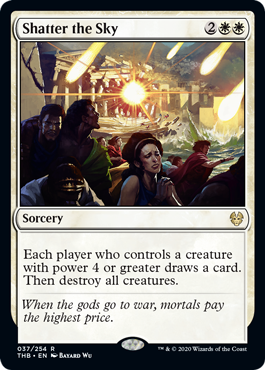
Grade: C+
Home: Control Decks, Board Wipe Decks
Range: Narrow
4 CMC wraths rarely get added to EDH these days, so every Shatter the Sky we get makes Fumigate and the typical standard legal 5 CMC wiper look like trash. The last board wipe I really liked was Wings of Abandon, and that was in Modern Horizons at 6 CMC.
1) Idyllic Tutor
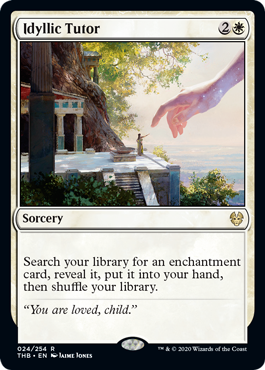
Grade: A-
Home: Any Deck with Enchantments
Range: Wide
Since most every EDH deck packs enchantments for removal, utility, value, or win-con, Idyllic Tutor is an old friend we haven’t seen since Morningtide. A great reprint of an EDH beloved card that sees moderate usage but a two digit price is very welcome.
Highly recommend of buying a single when you can.
Honorable Mentions:
My fave cards that don’t quite cut it.
Eidolon of Obstruction - A super niche card, but it can really annoy a superfriend player’s day. With good stats and a creature type for a 2 drop, it’s fairly solid - but in a format like EDH where mana
Elspeth Conquer’s Death - Dear heavens, this card is clunky and slow, but I love every step of it. Hard exile removal which can hit a lot of problem creatures is great. Messing with your opponents ability to spellcast is also nice, but niche. Resurrection with a buff is also nice, but your opponent had several turns to deal with the Saga or use GY hate. It’s like White getting The Eldest Reborn, but not nearly as good.
The Birth of Meletis - A great card for a Control deck to have. It gets you land (fixing mana with Dual lands in Multicolor Decks), it has some early defense, and a touch of lifegain. It’s like a more specific Angelic Wall.
Sentinel’s Eyes - A very cheap, recursive-capable Aura has some potential
27 notes
·
View notes